Wise Stock: Underrated FinTech is more than a money transfer app
CentralITAlliance/iStock via Getty Images
Wise Plc. (OTCPK:WPLCF) is going after the big opportunity to disrupt traditional banking. It started with international transfers, but is now going after core banking products.
We consider the stock a high-risk purchase, with an investment horizon of 10 years+, and an intrinsic value of USD 9.15 billion or USD 8.9 per share (GBP 7.8 or GBP 7.7 per share). The 1-year price target is estimated at GBP 8.4 (or $9.7) with an upside of 63%.
The main risk with an investment in Wise is the possibility of growth deceleration as it is a top-line focused business that must deliver network effects. The value from the business is primarily expected to come from additional services it will include along with the money transfer service.
The company has around 13+ million customers (around 5 million active) and has adopted one profitable model, with an emphasis on cutting costs to customers that seek to transfer funds and hold an international low–cost accounting. Active customer growth develops by 29% and 36% respectively for personal and business accounts.
What Wise sells
The company claims (02:40) to have “reinvented the way money moves in the world”, which shows its ambition to go beyond transfers and become an international online financial services company. Wise currently has 3 key products: Wise Account, Wise Business and Wise Platform.
Users with a personal account can transfer money, receive income, hold deposits and use a debit card. New features include UK investments, scheduled payments and automatic conversion. Wise has a transfer service that allows users to send and receive money international at a low share of 0.72%, which is part of their competitive strategy. Wise also offer one multi–currency accounting, which allows users to hold and Exchange several currencies. Personal accounts are currently growing at 29% annually, but may experience a slowdown as the economic climate slows.
The next key product is business accounts and services. Corporate deposits with Wise have increased by 240% from GBP 2 billion in FY2020 to GBP 6.8 billion in FY2022.
The company sees great opportunity in its business accounts, as it has begun offering services that closely resemble PayPal (NASDAQ:PYPL) and Stripe. The business service allows companies to open an alternative bank account with sorting code, IBAN and debit card. It can be used in invoicing, payroll and other transactions.
Image 1. Wise’s Business Account Offering Deck (Investor presentation)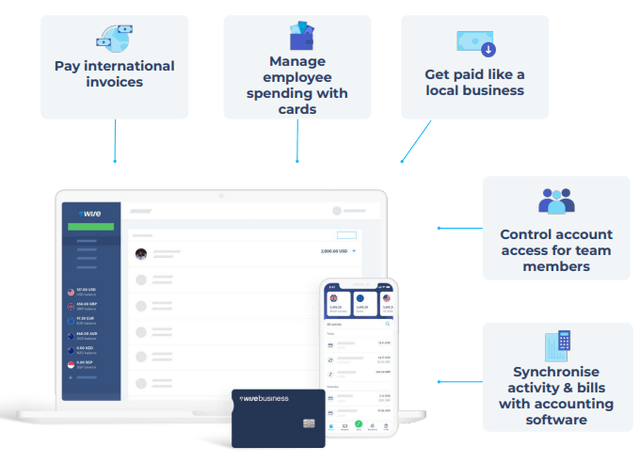
The fast execution and low cost of the account is becoming an attractive option for businesses, and Wise has grown active business customers by 36% year-on-year to 270k, while transaction volume has increased by 54% year-on-year to £5.5 billion.
The company is set to expand its product offering into an asset platform, where it will allow international users to hold stocks and other assets in their Wise account. It is currently available in the UK, with plans to expand to Europe. Note that the management indicates that this will take some time to realize.
The key here is that Wise is slowly becoming an online international bank with highly cost-effective financial services for individuals and businesses. Although the company doesn’t include this in their messaging, they seem to take on a lot more than money transfer companies.
Picture 2. Map of Wise’s latest development (Investor presentation)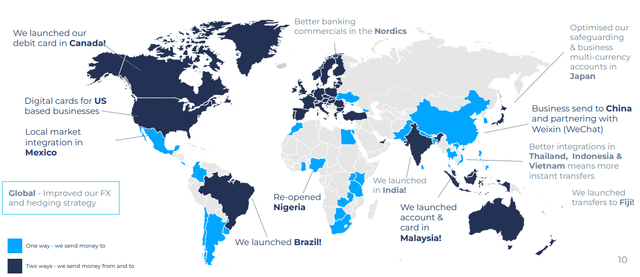
Building the SWIFT plugin
The latest development from Wise is an extension where they have built a new SWIFT Receive function for Wise Platform partners. This allows financial institutions not connected to the SWIFT network to now receive payments from around the world via SWIFT using their existing customer account details. The feature also enables financial institutions with an existing SWIFT setup to process these incoming SWIFTs more efficiently.
A wise approach
It’s important to acknowledge that the product strategy for Wise may not follow the traditional path of capturing market share and then growing monetization vertically, rather the team appears to be focused on building the most cost-effective product, supplementing it with higher margins. additional services.
The company highlights the increased use of their services as proof of the success of their approach.
Image 3. % of customers using multiple Wise services (Investor presentation)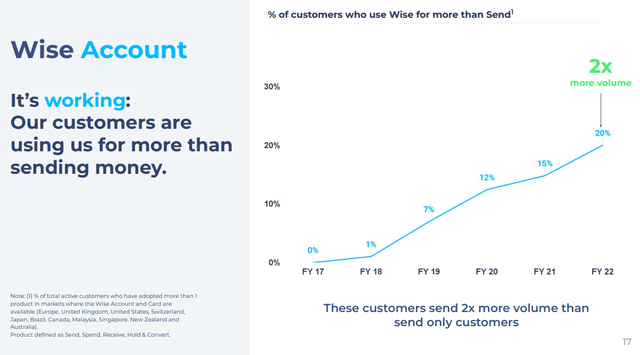
This will allow Wise to compete with larger companies on a price basis, and gain profitability from the additional services available on their platform.
A risk with this approach is that the company must be strong in several products, and competitors can eat away at its secondary services. Given the fact that Wise is not rushing product development, the company may be able to extract a competitive advantage in more than one service – this also means that investors will have to wait longer to see increasing margins, which hides the potential of the company and may not be a bad proposition for retail investors.
Note: VC and private equity investors are normally looking for a profitable exit in the short term, but retail can afford to wait for a longer build-up, ultimately choosing a truly valuable and disruptive business. Something that Valar Ventures (9.5% stake) can also support.
To reinvest in the business
As company, Wise focuses on disciplined expenditure, market share expansion, product development, and heavy price competition in order to Lower the cost to customers. The is placed in an industry with high barriers to entrance, tight competition, and fast develops technology. but, the is one of the cheaper platforms to transfer funds, which is also targeting debit card and business payment treatment services.
With a net income of GBP 42 million (5.8% margin) in the last 12 months, the company is operating profitably and using the free cash flows to reinvest in the products, which are intended to feed into customer personalization.
Customer satisfaction needs work
Customers have reduced the average rating of the Wise app in the Play Store from 4.3 in February 2022 to 4.2 in September. While a rounded figure, the Play Store shows over 10 million installations, which is roughly the same number in the period February-September. Their score on Trustpilot also dropped from 4.6 in February to 4.5 in September.
Finally, Wise points out that their net promoter score is over 70%, and 2/3 of their new customers come from referrals. The Net Promoter Score is based on an internal survey that asks customers to what extent they are willing to recommend a service. Since the survey is quite easy to manipulate by any company, e.g. curate the selection, we cannot rely on NPS as a metric.
Looking at the customer experience, it is reasonable to assume that the company needs to put more effort into making its products more efficient for users. The ratings are still among the best in class, but the platform needs to be perfect to create value.
Basics and value
Over the past 12 months, the company had revenue of GBP 622.3 million, which grew 11.1% from GBP 559.9 QoQ, while year-on-year growth was 35.7% from 458.2 million in TTM ending Q1 2022.
Operating income was GBP 86.8 million, up 5.6% from GBP 82.2 million, which equates to a margin of 11.8%. This gives us the basis for our intrinsic value assessment.
By estimating that the company continues to show strong top-line growth, and a converging EBIT margin, we get the following model for Wise:
Image 4. Wise Future Estimates Valuation model (Author image created with data from Seeking Alpha)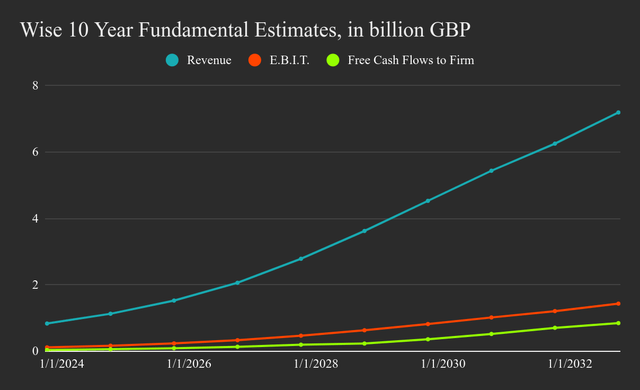
Analysts covering Wise forecast annual revenue growth of around 35% next year, and a slowdown of around 25% for the following years. We are more bullish in our estimates, predicting growth of 35% over the next 5 years, with a slight decline thereafter.
This accounts for the two key product categories of services:
- The transfer service that is on par, if not better, than Western Union (NYSE:WU).
- The new online banking service, which is the real disruptive catalyst for the company.
We have also extended the high growth period, from the standard 5 years to 7 years in our model (estimated growth >25% in years 6 and 7), as we believe the company will begin to see further growth as network effects materialize.
In our view, investors are pricing the stock as a money transfer app, while it’s more akin to what Airbnb ( NASDAQ:ABNB ) did to traditional hotels — offering a low-cost, high-quality service that allowed them to gain massive market share.
We see that the true competition for Wise is traditional banking services, which have become rigid and inefficient. While banks may modernize and offer faster and more convenient services, Wise appears to be laying the groundwork for consumer trust and broad network effects while pretending to be just a money transfer app. We believe that the company will increase in intrinsic value as it takes on additional online banking services, and also increase its price per share as it begins to provide investor returns in the late stages of (or beyond) the 10-year forecast period.
The other side of the company is profitability, while we trust (as assumed by management) that Wise will eventually reach an EBIT margin of 20%, investors should be more focused on the top line, and trust the company to reinvest as much as possible . into infrastructure and growth.
In conclusion, we estimate an intrinsic value of GBP 7.9 billion or GBP 7.7 per share. We set a 1-year price target of GBP 8.4 per share, representing a 63% upside from Friday’s close. Converted to USD, the intrinsic value is up to $9.15b or $8.9 per share, with a price target of $9.7.
Image 5. Wise’s estimated intrinsic value vs market value (Author image created with data from Seeking Alpha)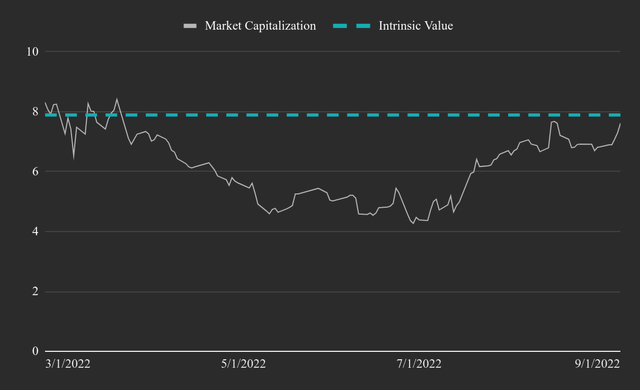
You can copy the entire excel model here, or open the view-protected version here.
Risks and possible investment approach
We have seen a decline in customer satisfaction on public review sites. If the company rushes its products, network effects will be more difficult to produce. The presented valuation model is very bullish, and should there be a slowdown in growth, the company could immediately fall in value. In this case, investors must ask themselves whether a drop is a temporary reflection of macro variables or a permanent reduction in the viability of their business model.
The other notable risk is competition, but Wise seems to have set up an agile process that is difficult to incorporate into mature companies, especially banks. The bigger risk factor is small tech startups that can take advantage of future technological improvements that reduce the cost of building fintech infrastructure. Major cloud providers are also increasing their technology offerings, which are intended to make building this infrastructure cheaper and easier.
This stock is probably the most suitable for a long investment strategy, where investors need to be aware that the stock is estimated to be highly volatile, before starting to reap the investment returns. Given the young phase of the company’s life cycle, this appears to be a 10+ year investment, with possible position increases as the price falls below value. Based on the company’s Black-Scholes model (p. 151), the expected annual volatility of the stock is 48%, giving investors a frame of reference for distinguishing between signal and noise in price movements.


